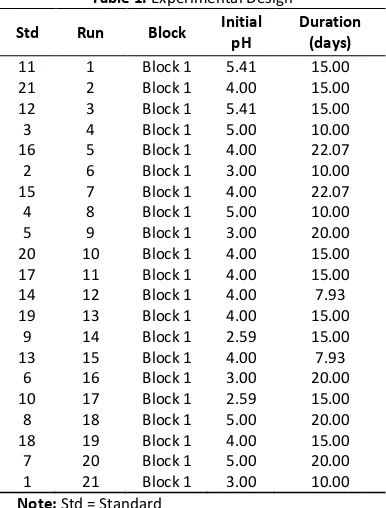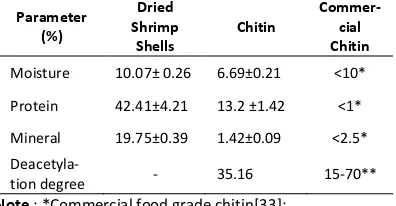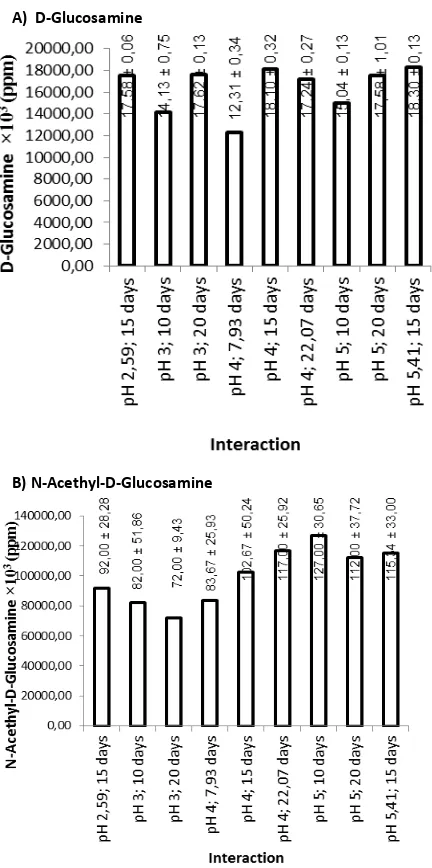Study of Glucosamine Production from Shrimp Shells by Fermentation
Using
Trichoderma harzianum
Hardoko
*, Bambang B. Sasmito, Yunita E. Puspitasari, Hamid M. Afandi,
Nugroho Maulia
Faculty of Fisheris and Marine Sciences, University of Brawijaya, Malang, Indonesia
Abstract
Shrimp shells are one of chitin sources in Indonesia which is potential to be converted into multifunctional glucosamine. This research was aimed to study the glucosamine production by fermentation using Trichoderma harzianum. Method used was experimental fermentation with pH treatment of 3-5 and fermentation duration of 10-20 days, and designed using Response Surface Methodology (RSM). Results showed that fermentation duration of 10-20 days has reached the optimum point of glucosamine production from shrimp shells using T. harzianum. The highest production of D-glucosamine in fermentation using T. harzianum occurred on initial pH of 5.41 and fermentation duration of 15 days (18,294.95 ppm), while the highest N-Acethyl-D-Glucosamine production occurred on initial pH of 3.00 and fermentation duration of 20 days (127,000.00 ppm).
Keywords: fermentation, glucosamine, shrimp shells, T. harzianum.
INTRODUCTION
Shrimp is one of the important export commodities for fishing industry in Indonesia. Majority of shrimp export from Indonesia is done in form of frozen unshelled shrimp, therefore shrimp shell is considered as waste or unused by- products. The shrimp waste produced is around 30-35% of total weight of a shrimp [1]. Shrimp waste, such as shells can cause environmental problem if they are left unutilized.
Meanwhile, shrimp shells contain 25-40% of protein, 45-50% of calcium carbonate and 15-20% of chitin, depend on the types of shrimp [2]. Thus, shrimp shells can be used as a source of protein, calcium and chitin. Among those three components, the most potential component, in terms of economic value, is chitin. This is because chitin and its derivatives are very useful to be used in many industrial fields [3].
Chitin and its derivatives are commonly used in several fields, such as medical and health, i.e. they can be used as immunoadjuvant (non-specific stimulator of immune response) and basic material to make surgical suture [4]. N-acetyl glucosamine compound, the product of chitin hydrolysis, is used in treatment of osteoarthritis and used as supplement [5,6]. In aesthetic field, chitin derivatives can be used as basic ingredients for cosmetics, toothpaste, body cream and hair treatment products. In textile,
Correspondence address:
Hardoko
Email : [email protected]
Address : Faculty of Fisheries and Marine Sciences, University of Brawijaya, Jl. Veteran , Malang 65145
they are widely used as coating material for cellulose fiber, nylon, cotton and wool [4].
Glucosamine is one of chitin derivatives that are widely used. Glucosamine production can be done physicochemically [7-11], enzymatically [12-15] and microbiologically [16]. To produce glucosamine chemically is relatively fast, but the chemical compounds used are dangerous for the environment, meanwhile to produce gluco-samine enzymatically, the limitations are on the stability of enzyme and enzyme extraction cost that are quite expensive [17,18]. To produce monomer (likes glukosa, glucosamine) using microorganism is more advantageous because it is easier, more practical and the waste does not pollute the environment [19].
Glucosamine production using micro-organisms is usually done by fermentation. There are many kinds of microorganisms, including bacteria and molds that can produce chitinolytic enzyme that can break down chitin into glucosamine. One of the microorganisms that can produce chitinase quite actively is Trichoderma. One of the strains, T. viride, produces chitinase enzyme with enzyme activity value of about 210.14 U.mg-1 [20].
Trichoderma have several strains and in this
research, the characteristics of Trichoderma harzianum in fermenting chitin into glucosamine with different pH condition and fermentation duration using RSM method, was studied.
MATERIALS AND METHODS
or random variables applied in this fermentation experiment were pH (X1 = 3, 4, 5) and
fermenta-tion durafermenta-tion (X2 = 10, 15, 20 days). The
determination of fermentation duration was based on report [21,22] that optimum fermentation duration of Trichoderma was 15 days, whereas the pH of fermentation was based on optimum pH for T. harzianum growth [23], i.e. pH of 5.6. The experimental matrix was derived by Software Design Expert, as can be observed on Table 1. The fixed factor was nutrition composition inside the fermentation media (KH2PO4 and MgSO4) and fermentation
tempera-ture, i.e. about 30°C (room temperature). Therefore, the treatment applied in this research was combination from initial pH column and duration column, i.e. 21 treatments (run column).
Table 1. Experimental Design
Std Run Block Initial
Preparation of Chitin from Shrimp Shells Chitin isolation from Vannamei shrimp shells was performed by demineralization step using HCl and deproteination using NaOH [24]. First,
Vannamei shrimp shells were washed and dried
under sunlight until dry and then milled using Buhrmill and sieved using 60 mesh sieve to obtain shrimp shells powder.
Shrimp shells powder was then added with
aquadest to remove the remaining HCl. Then, the solid was dried in the oven with temperature of 70°C for 24 hours and cooled inside the desiccator, to obtain low mineral shrimp shells powder.
Demineralized shrimp shells powder was put into beaker glass and added with 3.5% NaOH solution with ratio of 1:10 (w/v). The mixture was then heated at temperature of 65-70°C for 4 hours under agitation of 50 rpm. The mixture was filtered to obtain chitin solids and washed with aquadest until neutral pH is obtained.
Fermentation of Chitin from Shrimp Shells using
T. harzianum
Fermentation of chitin using T. harzianum was performed using semi solid fermentation system. The substrate consists of 5 gram of chi-pH was set according to the treatment using 0.1 M NaOH and/or 0.1 M HCl. Each substrate was added with 1 mL of T. harzianum spore and fermented at room temperature using shaker fermenter.
Chitinolytic Activity Test by Clear Zone Measure-ment
Chitinolytic activity test was done by observing the clear zone formed on agar media enriched with chitin, surrounding the growth of molds. Agar-chitin media was made from PDA added with 0.5% colloidal chitin (w/v media) [26, 27] and acidified using 50% lactic acid for about solidified, a well with 6 mm diameter was made,
aseptically. Then, 20 μL of T. harzianum spores
with density of 20.48×107.mL-1, 38.48×107.mL-1,
63.52×107.mL-1, 158.72×107.mL-1, were
Glucosamine Analysis using Spectrophotometry Method [29]
About 0.01 gram of fermented sample was dissolved uisng 1 mL of 0.25 M CH3COONa to
obtain concentration of 10,000 mg.L-1. This
solu-tion was then diluted gradually until concentra-tion of 12 ppm and 100 ppm were obtained. Each sample (concentration of 12 ppm and 100 ppm) was reacted with same concentration of PITC. The absorbance of sample solution of 12 ppm concentration that has been added with PITC was determined using UV-Vis spectrophotometer at wavelength of 273 nm to obtain absorbance of D-Glucosamine compound. Meanwhile, the ab-sorbance of sample solution of 100 ppm concen-tration that has been added with PITC was de-termined using UV-Vis spectrophotometer at wavelength of 584 nm to obtain absorbance of N-Acethyl-D-Glucosamine compound. These absorbance results were then plotted on standard curve of D-Glucosamine and N-Acethyl-D-Glucosamine.
Standard curve of D-Glucosamine and N-Acethyl-D-Glucosamine were prepared by dissolving 0.01 gram of standard D-Glucosamine or N-Acethyl-D-Glucosamine in 10 mL of 0.25 M CH3COONa and allowed to stand for 24 hours (to
stabilize the solution). After that, standard D-Glucosamine or N-Acethyl-D-D-Glucosamine soluti-on with csoluti-oncentratisoluti-on of 1,000 ppm as a stock solution was obtained. The stock solution was then diluted to obtain concentration of 3, 6, 9 and 12 ppm. About 10 mL of each solution was added with 10 mL of PITC solution, homogenized for 5 minutes and derivatives compound, i.e. phenylthiourea (PTH), was obtained. The absorbance of this compound can be determined according to the wavelength used. In this case, PITC solution was prepared by dissolving PITC using methanol that has the same concentration with glucosamine standard solution.
RESULT AND DISCUSSION
Characteristics of Chitin from Shrimp Shells Table 2 shows that chitin used has not fulfilled the commercial chitin standard in terms of protein content, although its moisture content, mineral content and deacetylation degree have fulfilled the commercial chitin standard. High protein content in chitin indicates that deproteination process was not enough. This might be caused by insufficient NaOH concentra-tion and/or insufficient deproteinaconcentra-tion process. Effectivity of deproteination process depends on the concentration of basic solution and
tempera-ture used [30]. Besides, protein content of chitin is related to its moisture content [30]. Lots of which is about 60-65% [32].
Table 2. Characteristics of Chitin and Dried Shrimp Shells
Parameter
Note : *Commercial food grade chitin[33]; **Chitin standard Protan Laboratories[34]
therefore there was no growth competition among the molds. Thus, T. harzianum can work optimally to degrade chitin during fermentation. Chitin degradation is done by chitinase enzyme that has different activity based on the types and stage of growth of microorganisms, and factors which influence the growth of microorganisms, such as pH, temperature and fermentation peri-od [12,37,38]. Chitinase activity from
Tricho-derma sp. and T. viridae was 33.19 IU.mL-1 and
18.77 IU.mL-1, respectively [20].
Glucosamine Production
Glucosamine that is obtained from chitin fermentation can be in form of D-glucosamine and N-Acethyl-D-Glucosamine. The correlation between pH and fermentation duration of shrimp shells chitin for glucosamine production according to RSM program can be observed on Figure 1.
A) D-Glucosamine
B) N-Acethyl-D-Glucosamine
Figure 1. Three-dimensional RSM graph of correlation between pH and fermentation duration of shrimp shells chitin for glucosamine production using T. harzianum
Three-dimensional RSM graph on Figure 1 shows the flat shape of correlation between pH and fermentation duration of shrimp shells chitin for glucosamine production, which means there was no optimum point. This phenomenon shows
there was no significant effect of fermentation duration and pH on D-Glucosamine and N-acetyl-D-Glucosamine obtained. This might happen because the fermentation duration was too long; therefore the production of D-Glucosamine is already maximum since the first observation (day 10) and there was only slight difference in glucosamine content on the following observations. It is based on a previous research that stated the production of chitinase by fermentation using T. harzianum reached its highest amount after 72 hours (day 3) when T. harzianum mycelia starter was used and after 96 hours (day 4) when T. harzianum spore starter was used [39].
This statement is also supported by another research that stated chitinolytic activity of T. harzianum reached its optimum amount in between day 2 and day 3 [40]. No significant change of glucosamine production after it has reached its optimum point is also in accordance with a research [41] which stated after 172 hours, glucosamine fermentation using T. harzianum mold starter did not undergo significant increase. Because there was no optimum point for glucosamine production, the glucosamine production can be observed based on interaction between pH and fermentation duration, as can be seen on Figure 2.
Figure 2 shows that the highest D-glucosamine amount obtained from pH treatment of 5.41 and fermentation duration of 15 days, which produces D-glucosamine content of 18,294.95 ppm. This amount of glucosamine is still higher compared to other research reports. Fermentation using chitinase from Pseudomonas sp. was optimum after 35 hours, which produces 0.164 mg.mL-1 164 ppm of glucosamine [14],
using Actinomycetes ANL-4 starter produces highest glucosamine about 9,784.25 ppm on day 5 [29], using Aspergillus sp. BCRC 31742 produces highest glucosamine of 7,480 ppm [42].
highest after 212 hours, which was about 190 ppm [40].
A) D-Glucosamine
B) N-Acethyl-D-Glucosamine
Figure 2. Graph of interaction between fermentation factors and their influence on glucosamine content
CONCLUSION
The fermentation duration applied on optimization of fermentation of shrimp shells chitin for glucosamine production using T.
harzianum was too long. The highest production
of D-Glucosamine from fermentation using T. harzianum occurred on initial pH of 5.41 and fermentation duration of 15 days, which reached about 18,294.95 ppm, whereas the highest production of N-Acethyl-D-Glucosamine occurred on initial pH of 3.00 and fermentation duration of 20 days, which reached about 127,000.00 ppm.
ACKNOWLEDGEMENT
The authors would like to thank Ministry of Research, Technology and Higher Education who has granted the research fund through INSINAS program, FY 2016.
REFERENCES
[1] Darmawan, E., S. Mulyaningsih, F. Firdaus. 2007. Karakteristik khitosan yang dihasil-kan dari limbah kulit udang dan daya hambatnya terhadap pertumbuhan Candi-da albicans. Logika. 4. 207-213.
[2] Foucher, J.P., G.K. Westbrook, A. Boetius, S. Ceramicola, S. Dupre, J. Mascle, J. Mienert, O. Pfannkuche, C. Pierre, D. Praeg. 2009. Structure and drivers of cold seep ecosystems. Oceanography. 22. 92-109.
[3] Hargono, Abdullah, I. Sumantri. 2008. Pembuatan kitosan dari limbah cangkang udang serta aplikasinya dalam mereduksi kolesterol lemak kambing. Reaktor. 12(1). 53-57.
[4] Kaban, J. 2009. Modifikasi kimia dari kitosan dan aplikasi produk yang dihasil-kan. Master Thesis. Department of Chemistry. University of North Sumatera. Medan.
[5] Sashiwa , H., S. Fujishima, N. Yamano, N. Kawasaki, A. Nakayama, E. Muraki, K. Hiraga, K. Oda, S. Aiba. 2002. Production of N-Acetyl-D-Glucosamine from chitin by crude enzymes from Aeromonas hydro-phila H-2330. Carbohyd.Res. 337. 761-763. [6] Kardiman, C. 2013. Manfaat glukosamin,
kondroitin, dan metilsulfonilmetana pada osteoartritis. CDK-211. 40 (12). 936-939. [7] Suptijah, P., B. Ibrahim, Ernawati. 2014.
Pemanfaatan limbah krustasea dalam pembuatan glukosamin hidroklorida dengan metose autoklaf. Jurnal Teknologi Perikanan dan Kelautan. 5(2). 173-181. [8] Dewi, N.L., S. Bahri, H. Jaya. 2016.
Penggunaan berbagai tekanan dan waktu hidrolisis pada produksi glukosamin hidroklorida dari kitosan cangkang Bekicot (Achatina fulica). Kovalen. 2(1). 22-32. [9] Nurjannah, A., Darmanto, I. Wijayanti.
2016. Optimasi pembuatan glukosamin hidroklorida (GLcN HCl) dari limbah cangkang udang rajungan melalui hidrolisis kimiawi. JPHPI. 19(1). 26-35.
National Seminar on Chemistry and Its Learning. 61-64.
[11] Zaeni, M., E. Safitri, I.N. Sudiana. 2017. Pembuatan glukosamin hidroklorida dari cangkang udang dengan energi microwave Jurnal Aplikasi Fisika. 13(1). 22-26.
[12] Widhyastuti, N. 2007. Produksi kitinase ekstraseluler Aspergillus rugulosus 501 secara optimal pada media cair. Berita Biologi. 8(6). 547-553.
[13] Widhyastuti, N., M Ilyas. 2012. Aktivitas dan karakter kitinase isolat Trichoderma sp. W34 A4 asal Kepulauan Raja Ampat Papua Barat. Biosfera. 29(1). 1-7.
[14] Wirawan, A., N. Herdyastuti. 2013. Penentuan waktu inklubasi pada pemben-tukan senyawa N-asetilglukosamin yang didegradasi secara enzimatis dari kitin. J. Chem. 2(3): 11-13.
[15] Purnomo, E.H., A.B. Sitanggang, D. Indrasti. 2012. Studi kinetika produksi glukosamin dalam Watermiscible Solvent dan proses separasinya. Proceeding of Seminar on Research Results. Bogor Agricultural University. Bogor. 24-25. [16] Sharaf, E.F., A.E.Q. El-Sarrany, M. El-Deeb.
2012. Biorecycling of shrimp shell by Trichoderma viride for production of antifungal chitinase. Af. J. Microbiol. Res. 6 (21). 4538-4545.
[17] Palonen, H. 2004. Role of lignin in the enzymatic hydrolysis of lignocellulose. VTT Biotechnology. Helsinki University of Technology, Espoo, Finland.
[18] Taherzadeh, M.J., K. Karimi. 2008. Pre-treatment of lignocellulosic waste to improve bioethanol and biogas producti-on. Int. J. Mol. Sci. 9. 1621-1651.
[19] Suhartati, F.M., W. Suryapratama, N. Iriyanti. 2003. Sintesis asam amino metionin pada Trichoderma reseii dan pengaruhnya terhadap sintesisis protein mikroba rumen. Jurnal Peternakan dan Lingkungan. 9. 12-16.
[20] Khikmah, N., S. Margino, R.S. Kasiamdari. 2016. Isolasi, seleksi, dan identifikasi kapang kitinolitik yang diisolasi dari tanah pembuangan limbah udang dan Rizosfer Solanaceae. Biota. 1(1). 1-8.
[21] Saparianti, E., T. Dewanti, S.K Dhoni. 2012. Hidrolisis ampas tebu menjadi glukosa cair oleh kapang Trichoderma viride. Jurnal Teknologi Pertanian. 5(1). 1-10.
[22] Montesqrit. 2007. Isolasi dan karakterisasi selulase dari Trichoderma viride dan
Rhizopus spp dengan substrat jerami padi. Jurnal Peternakan Indonesia. 12(2).112-123.
[23] Kapat, A., S.K. Rakshit, T. Panda. 1996. Optimization of carbon and nitrogen sources in the medium and environmental factors for enhanced production of chitinase by Trichoderma harzianum. Bioprocess Eng. 15. 13-20.
[24] Puspawati, N.M., I.N. Simpen. 2010. Opti-masi deasetilasi khitin dari kulit udang dan cangkang kepiting limbah restoran seafood menjadi khitosan melalui variasi konsen-trasi NaOH. Jurnal Kimia. 4(1). 79-90. [25] Saskiawan, I., R. Handayani. 2011.
Hidro-lisis kitin melalui fermentasi semi padat untuk produksi N-Asetilgukosamin. Berita Biologi. 10(6). 121-127.
[26] Hsu, S.C., J.L. Lockwood. 1975. Powdered chitin agar as a selective medium for enumeration of Actinomycetes in water and soil. Appl. Microbiol. 29(3). 422-426. [27] Cahyani, L. 2013. Pemanfaatan tepung
cangkang udang sebagai media produksi kitinase oleh bakteri kitinolitik Isolat 26. Bachelor Thesis. Department of Biology, University of Jember. Jember.
[28] El-Gholl N.E., A.C. Alfenas, P.W. Crous, T.S. Schubert. 1993. Description and pathoge-nicity of Cylindrocladium ovatum s. nov. Can. J. Bot. 71. 466-470.
[29] Utami, P.H. 2014. Penetapan waktu inkubasi optimum degradasi kitin oleh kitinase dari Actinomycetes ANL-4 secara spektrofotometri UV-Vis. Bachelor Thesis. Department of Chemistry. University of Lampung. Lampung. 45-46.
[30] Karmas, E. 1982. Poultry and seafood technology. Noyes Data Corporation. USA. [31] Knorr, D. 1991. Recovery and utilization of
chitin and chitosan in food processing waste management. Food Technol. 45(1). 114-122.
[32] Cha, D.S., M.S. Chinnan. 2004. Biopolymer-based antimikrobial packaging: a review. Critical Rev. Food Sci. Nutr. 44. 223-237. [33] Subasinghe, S. 1999. Chitin from shellfish
waste health benefits over shadowing industrial uses. Infofish. Int. 3. 58-65. [34] Bastaman, S., N. Aprinita, Hendarti. 1990.
[35] Herdyastuti, N., T.J. Raharjo, Mudasir, S. Matsjeh. 2009. Chitinase and chitinolytic microorganism: isolation, charactirization and potential. Indones. J. Chem. 9(1). 37-47.
[36] Pratiwi, R.S., T.E. Susanto, Y.A.K. Wardani, A. Sutrisno. 2014. Kajian pustaka: enzim kitinase dan aplikasi dibidang industri. Jurnal Pangan dan Agroindustri. 3. 878-887.
[37] Purkan, B., A. Azizah, Baktir, S. Sumarsih. 2014. Eksplorasi bakteri kitinolitik dari sampah organik : Isolasi dan karakterisasi enzim kitinase. Jurnal Molekul. 9(2). 128-135.
[38] Rachmawaty, Madihah. 2013. Potensi perlakuan awal limbah kulit udang untuk produksi enzim kitinase oleh Trichoderma virens pada fermentasi substrat padat. Jurnal Bionature. 14(1). 33-37.
[39] Sandhya, C., L.K. Adapa, K.M. Nampoothiri, P. Binod, G. Szakacs, A. Pandey. 2003. Extracellular chitinase production by Trichoderma harzianum in submerged fermentation. J. Basic Microbiol. 44(1). 49-58.
[40] Nampoothiri, K.M., T.V. Baiju, C. Sandhya, A. Sabu, G. Szakacs, A. Pandey. 2003. Process optimization for antifungal chitinase production by Trichoderma harzianum. Process Biochem. 39. 1583-1590.
[41] Bohlmann, J.A., D.O. Schisler, K. Hwang, J.P. Henning, J.R. Trinkle, T.B. Anderson, J. Donald, A. Vanderhoff. 2004. Acetyl-D-Glucosamine and process for producing N-Acetyl-D-Glucosamine. United States Patent US 6,693,188 B2.
[42] Sitanggang, A.B., H.S. Wu, S.S. Wang, Y.C. Ho. 2010. Effect of pellet size and stimulating factor on the glucosamine production using Aspergillus sp. BCRC 31742. Biores. Technol. 101(10). 3595-3601.


![Figure 1. between day 2 and day 3 [40]. No significant change of glucosamine production after it has](https://thumb-ap.123doks.com/thumbv2/123dok/2882279.1696905/4.595.87.260.337.634/figure-day-day-significant-change-glucosamine-production.webp)
